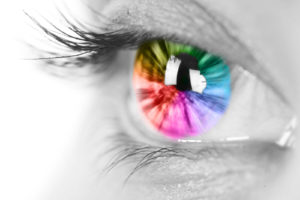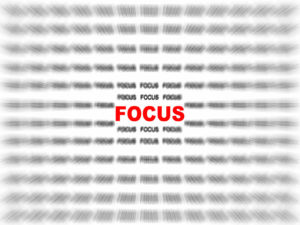
A Simple Way of Understanding How Vision Works
Have you ever stopped to wonder how vision works? We talk so much about eyesight and seeing well. But, we talk less about the intricate functions inside the eye. Many people never stop to think about the actual process involved in sight. They take it for granted that their eyes are doing what they are supposed to be doing.
To be fair, most of us never stop to think about how other muscles in the body work, either. However, it’s important to note that the gift of eyesight is a complicated mechanism that we’ll attempt to describe in this post.
Many different parts of our eyes need to be healthy so that we can see. And, they need to work well together. Keep reading to learn more about the intricate process your eyes go through to help you see.
 The Eye as a Camera
The Eye as a Camera
One way to think about eyesight is that it’s similar to how a camera works. There are many different steps a camera must process before you get to see a photograph or a movie.
Recording something with a camera is similar to the eyes viewing something. The eyes have a process they must go through before you can see an image (though this process happens at the speed of light).
The first step in understanding how vision works is understanding the role that light plays. Light rays are reflected or bounced off objects before entering into our eyes.
Light Affects How Vision Works
Our corneas are the transparent parts of our eyes that process these light rays. The cornea refracts the light rays through our pupils. This is why our pupils sometimes look bigger and smaller depending upon how much light is getting processed by our corneas. For example, if you are standing in sunlight your pupils will be smaller. But, if you’re in a dimly lighted room, your pupils will expand to allow the maximum amount of light to get through.
After the light rays move through our pupils, they pass through the lens of our eyes. The lenses of our eyes are directly behind our irises (the colored part of our eyes). And, like the cornea, our lenses are also clear.
The lenses of our eyes focus all the light rays and send them to our retinas, located at the back of the eye.
The retina, which contains millions of nerve cells that sense light, is a thin layer of eye tissue. In the center of our retinas lives the macula, which functions like a sponge.
The macula absorbs blue and ultraviolet light and blocks the sun’s rays from damaging our retinas. The retina uses special light-processing cones and rods to communicate with our nerves. It sends impulses when processing colors and details.
These impulses from the rods and cones tell our brains how to interpret the light rays. Thankfully, all of this happens at the speed of light so that we can see in real time!
As you can see, vision is a very intricate process. It’s dependent upon many different things going right before we see clearly. For our eyes to see clearly, it’s important that all the parts work well together.
Like many other people, you have probably taken your ability to see for granted. After all, you’ve been able to see ever since you were born. It’s not until something begins to go wrong with our vision that most people take the time to learn more about how vision works.
Our corneas, pupils, lenses, and retinas (and the millions of cells within them), must be in working order for our brains to “see” an image. Therefore, it’s so important to keep our eyes healthy and strong. Problems with any of the separate parts that make up our eyes can cause vision problems. As we age, these problems become more serious and can lead to the need for corrective lenses, surgery, or even blindness.
Take good care of your eyes by eating a healthy diet and consider supplementing with vitamins for eye health. You can also keep your eyes in shape with our simple eye exercises.
Diet
One natural way to protect your eyes and all their hard-working parts is to expand your diet. It should include foods which contain the vitamins and minerals that your eyes need. Many of the vitamins and minerals needed by your eyes are good for your overall health as well. So, by taking care of your vision, you’re also taking care of the rest of your body.
What are the various eye-health vitamins? Some of the most necessary nutrients are antioxidants and minerals. Within these two groups, there are vitamins C, E, and D, as well as zinc, iron, and omega-3. Of course, drinking more water is also part of a healthy diet. Drink less soda and more water to start your eye-healthy journey.
Of course, some of our busy lives make it difficult to spend extra time meal prepping nutrient-dense meals. That’s why turning to supplements like our Ocu-Plus formula can be so useful. They provide you with 17 vitamins and minerals to support your eye health.
Exercise
Exercise doesn’t just keep your body in shape, it plays a major role in the health of your eyes as well. Cardiovascular workouts, like aerobics, have been proven to lower intraocular pressure. This is especially beneficial to people suffering from glaucoma.
Doing regular cardio exercise will also increase the flow of blood to the optic nerve and the retina. Thus, helping your eyes to function properly for many, many years to come.
You can also do exercises specific to the eyes. These eye exercises work the muscles in and around the eyes to build strength. They also increase flexibility and agility. When your eyes’ muscles are in good shape, they’re able to control your eyes much easier.
The eyes comprise of many different functions and components. When one function is broken, the rest are affected. It’s crucial you take care of your eyes from the inside out if you want them to stay healthy.
Our Rebuild Your Vision Ocu-Plus Formula Contains All 17 Vitamins, Minerals, and Herbal Supplements to Improve Your Eye Health!












Thanks Tyler. I am impressed by the data you publish, regarding eye health. What you print makes sense and is valued. As I age, I’m becoming more focused on searching out factual information and using this to build my life on.
Fact is something has to actually work, for me to even consider using it. Eye exercises make the eye stronger and flexible. Whilst I’m loath to admit it, I do eye exercises because I read your emails. [Should be doing them because I see better].
Hmm, keep sending your emails. Apparently I’m in a motivational drain. Warm regards, Tom.
The key to natural vision improvement is consistency 🙂
Do you have any suggestions for what are the best non-Rx sunglasses for blocking UV & blue light (to help when we have “mild macular degeneration” per my eye doctor?
Also, I have been doing eye exercises for 150 days now, I am having new glasses for work done using a lower Rx than before, as you suggested, because I need to be able to see clearly to work on spreadsheets all day on computer. Once I retire I hope to get rid of glasses for ever!!
Congratulations on your vision improvement. We love hearing success stories. 🙂 As far as the sunglasses go, we recommend speaking to your eye doctor about this as every case is different.